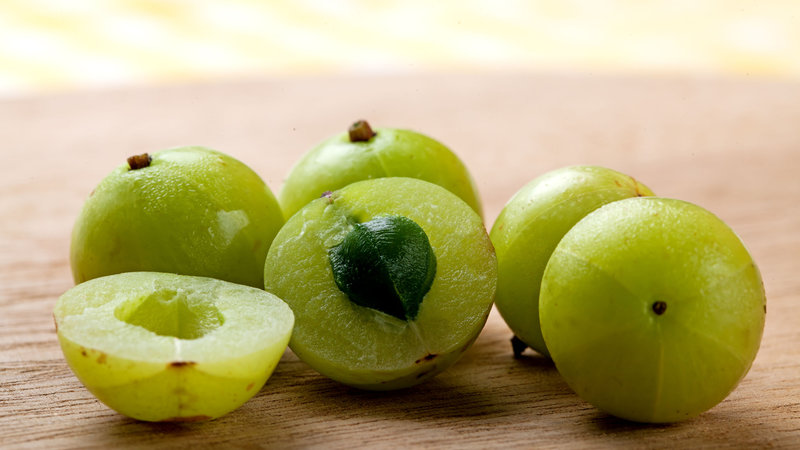Amla: The Immunity-Boosting Superfruit With Many Names
Amla, also known as Indian Gooseberry, holds a prominent and revered place in Ayurveda, the ancient Indian system of holistic healing. This potent fruit is highly regarded for its multifaceted contributions to health and well-being.

In Ayurveda, amla is recognized for its unique balance of five fundamental tastes – sweet, sour, bitter, astringent, and pungent – making it an exceptional dietary inclusion that supports both mind and body.
Amla’s therapeutic properties are harnessed in various Ayurvedic formulations, where it plays a crucial role in enhancing digestion, boosting immunity, promoting radiant skin, and revitalizing hair health. Its cooling properties help pacify excess heat and inflammation, making it valuable for balancing the body’s internal harmony.
In Ayurvedic texts, amla is often referred to as “Amalaki” or “Dhatri,” both of which emphasize its nurturing and healing qualities. It is commonly utilized in herbal concoctions, powders, and tonics to address a wide spectrum of health concerns, from bolstering the immune system to rejuvenating tissues and supporting detoxification.
The holistic approach of Ayurveda recognizes amla’s potential to harmonize not only physical health but also mental and spiritual well-being. As an integral part of Ayurvedic practice, amla continues to demonstrate its significance as a natural remedy that aligns with the principles of balance and holistic living.
Amla A Divine Medicine
Amla is often termed a ‘divyaushada,’ signifying a divine medicine, owing to its composition of five distinct tastes – sweet, sour, bitter, astringent, and pungent. These tastes collectively contribute to the balanced functioning of both mind and body.
Nutrient-Rich Powerhouse
Amla’s healing potential knows no bounds, thanks to its abundant reserve of essential nutrients. This unassuming fruit is brimming with a wealth of vital elements that contribute to its remarkable health benefits.
From bolstering immunity to enhancing skin health, amla’s nutrient-rich composition makes it a true nutritional treasure trove.
1. Vitamin C: The Immunity Booster: Amla is renowned for its extraordinarily high vitamin C content. This potent antioxidant not only aids in boosting the immune system but also plays a pivotal role in collagen synthesis, contributing to healthy skin, strong bones, and efficient wound healing.
2. Calcium and Iron: Building Blocks of Strength: Calcium and iron, both crucial minerals, are present in amla in meaningful quantities. Calcium supports bone health and teeth integrity, while iron helps transport oxygen through the blood, preventing anemia and promoting overall vitality.
3. Phosphorous: Strengthening the Framework: Phosphorous is integral to the formation of healthy bones and teeth, aiding in energy production, and supporting the efficient functioning of cells and tissues.
4. Carotene and Vitamin B: Nurturing Wellness: Amla’s carotene content, a precursor to vitamin A, contributes to good vision, skin health, and immune function. Meanwhile, its vitamin B components play diverse roles in metabolism, energy production, and nerve function, promoting overall well-being.
5. Protein and Fiber: Sustaining Vitality: The presence of protein and fiber in amla is noteworthy. Protein is essential for muscle growth and repair, hormone production, and enzymatic functions. Fiber, on the other hand, aids in digestion, promotes satiety and maintains healthy cholesterol levels.
Religious Significance of Amla Fruit in India
Beyond its health benefits, amla holds profound religious significance. During the Hindu month of Kartik, which generally falls between October and November, amla plays a prominent role in rituals.
It is customary in many parts of India to offer amla as a Naivedya to Lord Shiva, considering it a gesture of reverence. Moreover, amla is consumed during this time to combat respiratory infections, common colds, the flu, and other health issues arising from imbalances in vata, kapha, and pitta – the three doshas according to Ayurveda.
Amla’s multifaceted nature transcends its role as a mere fruit; it emerges as a symbol of health, spirituality, and cultural practices. Its profound impact on physical well-being, combined with its revered place in tradition, reinforces the status of amla as a truly remarkable gift from nature.
Other Names for Amla Fruit
Amla, also known as Indian gooseberry, goes by various names in different languages, highlighting its widespread recognition and importance. Let’s explore the diverse names that this remarkable fruit is known by:
In Sanskrit
1. Amalki: This name reflects the fruit’s inherent goodness and nourishing properties, as “Amalki” translates to “nectar of life.”
2. Shriphala: “Shriphala” signifies the fruit’s auspicious nature, as “Shri” often conveys prosperity and blessings.
3. Sheetaphala: “Sheetaphala” alludes to the fruit’s cooling effects on the body, making it a valuable choice in hot climates.
4. Dhatri: As the “Dhatri” or caretaker of health, amla’s various benefits are well-captured in this name.
5. Tishyaphala: This name underscores the intense potency and therapeutic qualities of amla, making it a source of overall well-being.
Other Indian Names of Amla
The names in different languages highlight the cultural diversity and widespread recognition of the fruit known as Indian Gooseberry or Amla.
- English: Indian Gooseberry
- Kannada: Nelli
- Hindi: Amla
- Marathi: Avala
- Tamil: Nellikai
- Telugu: Usheeri kaya
- Malayalam: Nelli
Other Names of Amla Around the World
- Spanish: Grosella de la India
- French: Groseille d’Inde
- German: Indische Stachelbeere
- Italian: Grossularia indiana
- Russian: Индийская крыжовник (Indiyskaya kryzhovnik)
- Chinese (Simplified): 印度醋栗 (Yìndù cùlì)
- Japanese: インドグースベリー (Indo gūsuberī)
- Korean: 인도 바람딸기 (Indo baramddalgi)
- Arabic: الكشمش الهندي (Al kishmish al hindi)
- Turkish: Hint Kirazı
Benefits Of Eating Raw Amla
Amla, also known as Indian gooseberry, is a small, green fruit that has been revered in traditional medicine for its numerous health benefits.
1. Boosting Immunity Naturally
Vitamin C plays a crucial role in supporting the immune system, and amla stands out as one of the most abundant sources of this vital nutrient. Additionally, the potent antioxidant properties of amla aid in counteracting detrimental free radicals within the body.
2. Aiding Digestion and Metabolism
Raw amla contains dietary fiber that supports healthy digestion. Fiber promotes regular bowel movements, prevents constipation, and supports a balanced gut microbiome. Additionally, amla’s compounds are known to boost metabolism, which can aid in weight management and overall digestive health.
3. Glowing Skin and Healthy Hair
The antioxidants found in amla are not only beneficial for internal health but also for your skin and hair. Regular consumption of raw amla can help fight signs of aging, promote collagen production, and maintain healthy skin texture. Amla oil is also popular for nourishing the scalp, reducing dandruff, and enhancing hair shine.
4. Managing Blood Sugar Levels
Research suggests that amla may have a positive impact on blood sugar levels. Its anti-inflammatory and antioxidant properties can help improve insulin sensitivity, making it a valuable addition to the diet for individuals with diabetes or those aiming to manage their blood sugar levels.
5. Heart Health
Amla is known to support cardiovascular health in several ways. Its antioxidants help reduce oxidative stress, which is linked to heart disease. It also aids in maintaining healthy cholesterol levels and promoting proper blood circulation, thus contributing to overall heart health.
6. Enhancing Vision
The high content of vitamin C in amla is associated with a lower risk of age-related macular degeneration and cataracts. Regular consumption of raw amla can contribute to maintaining good vision and eye health.
7. Strengthening Hair
Amla is a popular ingredient in hair care products due to its ability to strengthen hair follicles, reduce hair fall, and promote hair growth. Including raw amla in your diet can provide the necessary nutrients for healthy and lustrous hair.
8. Natural Detoxification
Amla aids in detoxifying the body by promoting liver function and supporting the elimination of toxins. Its diuretic properties help flush out harmful substances, promoting overall body cleansing.
9. Bone Health
Amla contains calcium and phosphorus, both of which play a pivotal role in preserving robust bones and teeth. These minerals are vital for promoting bone health and can effectively reduce the risk of conditions such as osteoporosis.
Amla Products and Recommended Dosages
The Ayurvedic dosages for various Amla variants differ based on their forms. Here are the recommended dosages for different Amla products:
1. Powder: Consume half a teaspoon of Amla powder with lukewarm water. Frequency: Twice a day.
2. Capsule: Take 1 to 2 Amla capsules with a sufficient amount of water after meals. Frequency: Twice a day.
3. Tablet: Consume 1 to 2 Amla tablets with an ample amount of water after meals. Frequency: Twice a day.
4. Candy: Enjoy 1 to 3 Amla candies after your meals.
5. Juice: Take 3 to 4 teaspoons of Amla Juice before your meals. Frequency: Twice a day.
FAQs About Amla
1. Can I consume amla if I have a sensitive stomach?
Absolutely! Amla is gentle on the stomach and can actually aid digestion for many people.
2. Is it better to eat raw amla or consume it in another form?
Both forms have benefits, but eating raw amla ensures you get the maximum nutrients without any processing.
3. How can I incorporate raw amla into my diet?
You can eat it as is, add it to salads, make amla juice, or even mix powdered amla into your smoothies.
4. Are there any side effects of consuming too much amla?
While amla is generally safe, excessive consumption might lead to digestive discomfort or interact with certain medications.
5. Can raw amla help in weight loss?
Yes, the fiber content in amla can promote satiety and support weight management efforts.
Incorporating raw amla into your diet can be a game-changer for your overall health and well-being. From boosting your immune system to promoting glowing skin, healthy hair, and strong bones, the benefits of consuming this nutrient-rich fruit are undeniable.
References:
- Functional and Nutraceutical Significance of Amla (Phyllanthus emblica L.): A Review(1)
- Clinical Study to Evaluate the Efficacy and Safety of a Hair Serum Product in Healthy Adult Male and Female Volunteers with Hair Fall(2)
- Phyllanthus emblica (Amla) Fruit Powder as a Supplement to Improve Preweaning Dairy Calves’ Health: Effect on Antioxidant Capacity, Immune Response, and Gut Bacterial Diversity(3)
- Evaluation of the effects of a standardized aqueous extract of Phyllanthus emblica fruits on endothelial dysfunction, oxidative stress, systemic inflammation and lipid profile in subjects with metabolic syndrome: a randomised, double blind, placebo controlled clinical study(4)


























